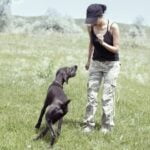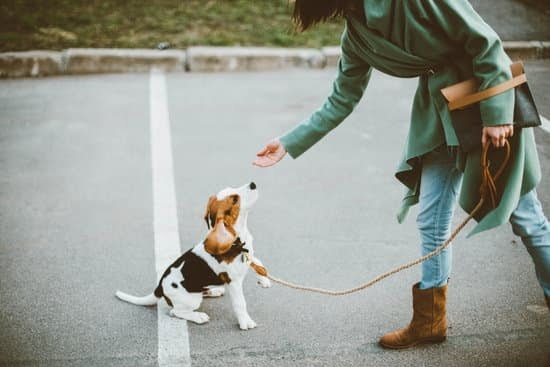Are you tired of your dog constantly pulling on the lead during walks? Learning how to train your dog not to pull on the lead can make your walks more enjoyable for both you and your furry companion. Understanding why dogs exhibit this behavior is crucial in addressing it effectively.
Dogs may pull on their leads for various reasons, such as excitement, curiosity, or lack of training. It is natural for dogs to be inquisitive and want to explore their surroundings, which can often manifest as pulling on the lead. However, this behavior can be frustrating for owners and potentially dangerous if not corrected.
Training your dog not to pull on the lead is essential for their safety and your convenience. A well-trained dog that walks calmly by your side makes outings more pleasant and prevents any potential accidents or injuries. By investing time and effort into leash training, you can enjoy stress-free walks with your canine companion.
The Importance of Training Your Dog Not to Pull on the Lead
Understanding the Negative Impact of Pulling on the Lead
When a dog constantly pulls on their lead during walks, it can not only be frustrating for the owner but also harmful to the dog. The continuous pulling can result in physical strain on the dog’s neck and can lead to discomfort or even injury.
Additionally, a dog that pulls on the lead may become more difficult to control, which can pose a safety risk for both the dog and their owner. Understanding these negative impacts highlights the importance of training your dog not to pull on the lead.
The Benefits of Teaching Your Dog Proper Leash Etiquette
Training your dog to walk politely on a leash has numerous benefits. Not only does it make walks more enjoyable for both you and your furry companion, but it also strengthens your bond with your pet.
A dog that walks calmly beside you is easier to manage in various environments, whether you are walking through a crowded park or passing by other dogs on the street. By teaching your dog not to pull on the lead, you are setting them up for success and ensuring their safety.
Building Trust and Communication Through Leash Training
Training your dog not to pull on the lead is more than just preventing unwanted behavior – it is an opportunity to build trust and improve communication with your pet. When you establish boundaries and expectations during walks, you are reinforcing your role as a leader in your dog’s eyes.
By using positive reinforcement techniques and consistent training methods, you are effectively teaching your dog how to behave appropriately while strengthening the bond between you. With patience, consistency, and dedication, you can successfully train your dog not to pull on the lead and enjoy stress-free walks together.
Choosing the Right Equipment for Leash Training
When it comes to leash training your dog and teaching them not to pull on the lead, choosing the right equipment is crucial. The type of leash and collar you use can greatly impact the effectiveness of your training efforts. Here are some options to consider when selecting the appropriate gear for your dog:
- Flat collar: A simple flat collar is a good starting point for leash training. Make sure it fits snugly around your dog’s neck without choking them.
- Back-clip harness: Harnesses that clip on the back are often recommended for dogs who tend to pull on the lead. These distribute pressure more evenly across the chest, reducing the likelihood of neck strain.
- Martingale collar: Martingale collars tighten slightly when your dog pulls, providing gentle feedback without causing harm. They can be effective for leash training while still being safe and comfortable for your furry friend.
It’s important to properly introduce your dog to whatever equipment you choose, as they may need some time to adjust. Allow them to get used to wearing their collar or harness around the house before starting leash training sessions. Remember that every dog is different, so you may need to try out a few options before finding the one that works best for your canine companion.
Lastly, never use equipment like choke or prong collars for leash training. These can cause unnecessary pain and discomfort, leading to a negative association with walking on a lead. Positive reinforcement and patience are key when teaching your pup how train dog not to pull on lead in a safe and humane way.
Step-by-Step Guide on Teaching Your Dog to Walk on a Loose Leash
Understanding the Basics
Before diving into the step-by-step process of teaching your dog to walk on a loose leash, it’s essential to understand why dogs tend to pull when on a lead. Dogs are naturally curious and energetic animals, so they may pull because they are excited about exploring their surroundings or because they want to move at a faster pace than you. Additionally, pulling can also be a result of lack of training or inconsistent reinforcement.
Introducing Proper Equipment
One crucial aspect of leash training is using the right equipment. Opt for a well-fitted harness or collar that does not cause discomfort to your dog. Avoid using retractable leashes as they can encourage pulling behavior. Instead, choose a standard leash that gives you better control over your dog’s movements during training sessions.
Step-by-Step Training Process
To begin teaching your dog how not to pull on the lead, start in a quiet and familiar environment free from distractions. Hold the leash with a firm but gentle grip and begin walking with your dog by your side. When your dog starts pulling ahead, stop in your tracks and wait until they come back to your side before resuming the walk.
Reward them with treats and verbal praise each time they walk without pulling. Remember, consistency is key in reinforcing this behavior.
By following these steps consistently and patiently, you can train your dog not to pull on the lead. With time and practice, walking on a loose leash will become second nature to your furry companion, resulting in enjoyable walks for both of you.
Techniques for Redirecting Your Dog’s Attention When They Start to Pull
Training a dog not to pull on the lead can be a frustrating experience, but with the right techniques, it is definitely achievable. One effective way to prevent your furry friend from yanking on the leash is by redirecting their attention whenever they start to pull. By teaching your dog to focus on you instead of whatever is causing them to pull, you can help them learn proper leash manners.
Here are some helpful techniques for redirecting your dog’s attention when they begin to pull:
- Use treats: Keep small, high-value treats handy during walks. When your dog starts to pull, hold a treat in front of their nose and lure them back into the correct position. Reward them with the treat once they are walking nicely by your side.
- Try changing direction: If your dog pulls on the lead, abruptly change directions and walk in the opposite way. This will make them pay attention to where you are going and help them understand that pulling does not get them where they want to go.
- Use verbal cues: Teach your dog a specific command like “heel” or “focus” that tells them to pay attention and walk politely beside you. Use this cue whenever they start pulling, and reward them when they respond correctly.
Remember that consistency is key when using these techniques. It may take time for your dog to learn not to pull on the lead, so be patient and keep practicing until they understand what is expected of them. With time and dedication, you can enjoy peaceful walks without worrying about your dog dragging you down the street.
Common Mistakes to Avoid During Leash Training
When it comes to leash training your dog and teaching them not to pull, there are several common mistakes that dog owners often make. It’s important to address these mistakes in order to effectively train your furry companion. One common mistake is using the wrong equipment for leash training. Using a regular collar instead of a harness can actually encourage pulling as it puts pressure on the dog’s neck, which can trigger a natural response to pull away.
Another mistake to avoid is inconsistent training. Training your dog not to pull on the lead requires patience and consistency. If you only correct them sometimes or give up easily, they will not understand what is expected of them. Consistency is key in reinforcing good behavior and teaching your dog how to walk nicely on a leash.
Additionally, avoid punishing your dog for pulling on the lead. Using harsh corrections or punishment can create fear or anxiety in your dog, which can result in even more pulling behavior. Instead, focus on positive reinforcement techniques such as rewarding good behavior with treats or praise.
This will help your dog understand what you want from them and encourage them to walk politely on the lead. By avoiding these common mistakes and using positive reinforcement methods, you’ll be well on your way to successfully teaching your dog how not to pull on the lead.
Consistency Is Key
Consistency is crucial when it comes to training your dog not to pull on the lead. Dogs thrive on routine and structure, so establishing a consistent training schedule is essential for their learning process. Set aside designated times each day for leash training sessions, ensuring that you stick to the same routine to reinforce good walking behavior.
When creating a training schedule, consider your dog’s daily routine and energy levels. Dogs tend to be more receptive to learning when they are well-rested and not overly stimulated. Choose times when your dog is calm and focused, such as after meal times or play sessions. Keep your training sessions short but frequent, aiming for around 10-15 minutes several times a day.
It’s important to remain patient and persistent during the training process. Rome wasn’t built in a day, and teaching your dog not to pull on the lead will take time and effort. Consistency in your approach will help your dog understand what is expected of them, leading to long-lasting results. The key lies in repetition, positive reinforcement, and maintaining a regular schedule that both you and your furry companion can adhere to.
| Training Tip | Details |
|---|---|
| Set specific training times | Choose consistent times each day for training sessions |
| Short but frequent sessions | Aim for 10-15 minute sessions multiple times a day |
| Be patient and persistent | Rome wasn’t built in a day – consistency pays off in the long run. |
Troubleshooting
Despite your best efforts in training, some dogs may continue to pull on the lead. It can be frustrating for pet owners, but it’s essential to remain patient and persistent in addressing this behavior. Understanding why your dog continues to pull is crucial in devising a successful strategy to correct it.
One common reason why dogs persist in pulling on the lead is that they have not yet grasped the concept of loose leash walking. In some cases, dogs may simply be too excited or distracted by their surroundings to focus on walking calmly beside their owners. It’s important to remember that leash training takes time and consistent practice, so don’t get discouraged if progress is slow.
To address this issue effectively, consider reinforcing basic obedience commands such as “heel” or “leave it” during walks. Use positive reinforcement techniques like praise, treats, or toys to reward your dog when they walk nicely on a loose lead. Additionally, make sure you are using proper equipment such as a front-clip harness or head halter to discourage pulling and provide better control during walks.
| Reasons for Dogs Pulling | Effective Strategies |
|---|---|
| Lack of understanding loose leash walking | Reinforcing basic obedience commands and using positive reinforcement |
| Excitement or distractions during walks | Utilizing proper equipment like front-clip harness and practicing patience |
Implementing these strategies consistently along with patience and positive reinforcement will help your dog learn how not to pull on the lead over time. Remember that every dog is unique, so it may take longer for some pets to adjust their behavior than others. Stay committed to the training process, and celebrate small victories along the way as your furry companion learns to walk politely by your side.
Celebrating Successes
Training your dog not to pull on the lead can be a challenging but ultimately rewarding endeavor. By understanding why dogs pull on their leads and the importance of proper leash training, you can set yourself and your furry companion up for success. Choosing the right equipment for leash training, such as a front-clip harness or a head halter, can make a significant difference in teaching your dog to walk on a loose leash.
Following a step-by-step guide and implementing techniques for redirecting your dog’s attention when they start to pull are essential components of successful leash training. It is crucial to avoid common mistakes during training and remain consistent in your efforts by creating a training schedule and sticking to it. Consistency is key in reinforcing positive behaviors and ensuring that your dog understands what is expected of them while walking on the lead.
Despite your best efforts, there may be instances where your dog continues to pull on the lead. In such cases, troubleshooting strategies can help address any setbacks in your training progress.
Remember that every small success should be celebrated along the way, as they are indicative of the hard work and dedication you have put into teaching your dog how to walk nicely on the lead. With patience, consistency, and positive reinforcement, you will soon enjoy the rewards of having a well-behaved canine companion by your side during walks.
Frequently Asked Questions
How Do I Train My Dog Not to Pull on the Lead?
Training your dog not to pull on the lead requires patience, consistency, and positive reinforcement. Start by teaching your dog to walk calmly beside you, rewarding them for good behavior. Use treats or toys to incentivize them to stay by your side and redirect their attention if they start pulling.
How Long Does It Take to Train a Dog to Not Pull on Leash?
The time it takes to train a dog not to pull on a leash varies depending on the individual dog’s temperament, breed, and previous training. On average, it can take several weeks to several months of consistent training for a dog to learn not to pull. It is important to be patient and continue practicing regularly.
How Do You Discipline a Dog That Pulls on the Lead?
When disciplining a dog that pulls on the lead, it is essential to use positive reinforcement rather than harsh punishment. Avoid yelling or physically correcting your dog as this can create fear and anxiety. Instead, focus on rewarding good behavior and redirecting their attention when they start pulling. Consistency is key in reinforcing the desired behavior over time.

Welcome to the blog! I am a professional dog trainer and have been working with dogs for many years. In this blog, I will be discussing various topics related to dog training, including tips, tricks, and advice. I hope you find this information helpful and informative. Thanks for reading!





